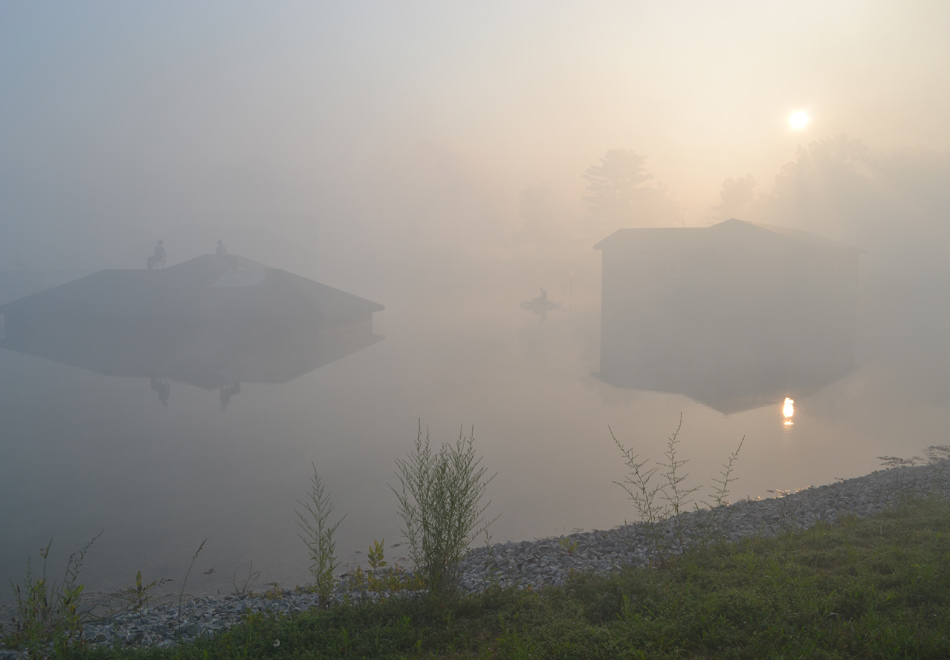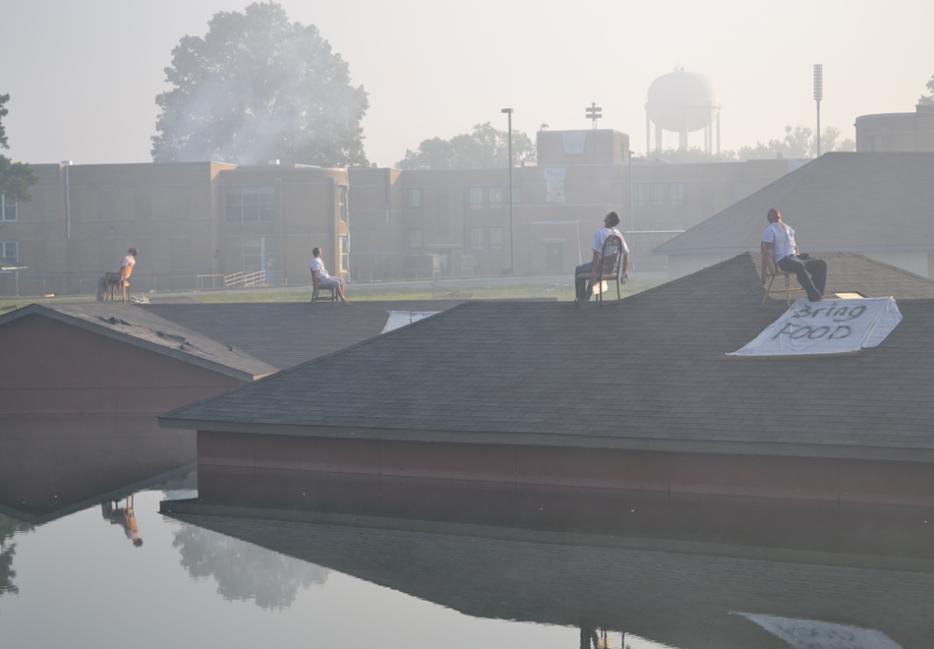The incandescent dispatches of the desperate burned through the fog, scrawled in urgent spray paint onto white bed sheets, seeming to flutter freely in the air: “The End of Days”—“Injured Children”—“We Need Food”—“Is This Living”—“✝ We Need a Priest”—“What Do You Got To Trade?” The floating cries briefly took my mind off the gruesome forms, took me back to the drive down to Indiana, over a hundred miles north up I-65, past the long, fat python bellies of blown tires; well before Indianapolis pulls herself up from the green; well before the towering windmills bridge the level plains of sky and field, to a sign just outside the city of Gary, visible heading southbound, white sans serif all caps on a black field: “HELL IS REAL.”
Our large grey Chevrolet van, its face smashed in like a pug dog, had led the convoy. Now we parked on the edges of the grievous sea of sunken homes alongside a white Ford Windstar mired in the water’s grassy edge, door ajar like a trauma victim’s eyes, revealing an interior faded and damp and almost laughingly macabre, thanks to the pair of tangerine bikini bottoms dangling from the post off the driver side door’s power lock. Outside, a scrap of blue and red tartan plaid hung ghastly from the van, pressed against the condensation-streaked back window by the rear wiper. On the roof sat a long metal pole, its rusted tips almost spearing my temple as I spun from the human forms sitting upon the lake, coming into focus through the fog.
By the time we had arrived in Hell—the rolling thunder of our trucks dying with pops and snarls, hisses, low rumbles, finally falling into lockstep with the eerie silence surrounding us—the sun had humped high enough above Indiana to resemble a dental lamp swaddled in dryer sheets, hot white fuzz obscured by mists both chemical and natural. The fog, opaque and ominous, stood biblically on the floodwaters, which lapped at the half-drowned homes of Boatman Road, each domestic ruin materializing in the reduced visibility like shipwrecks.

The foundation prevents the contaminated water the MCD produces—and there is a lot of it—from soaking into the ground. It’s instead diverted via sub pumps to massive orange bags the guardsmen called blivits, which swell like mosquito bellies with 1,200 gallons of contaminated water apiece, and are then emptied off to the side, leaving, in theory, almost no ecological footprint. There were two lanes in the 208th’s MCD, ambulatory and non; the ambulatory lane’s tent was divided by a white plastic partition into male and female sides, while a series of rollers allowed sledded suffering to be rolled through the non-ambulatory side, a casualty conveyor belt. Running at full capacity, the lanes could handle roughly 40 ambulatory (walking on their own power) people per hour, with the non-ambulatory number halved.
Each lane consisted of three sections: one for undressing (the clothes are cut off in the non-ambulatory lane) section; one for washing and rinsing; and one for monitoring, where radiological scans would assure every person was suitably clean. From here, the survivors were passed to the 1171st.
“We are a medical organization,” 1171st Captain Tim Finley said. He had the body of one of those semi-tall, not-too-thin types who work in running stores and have actual singlets to race 10Ks in, and his black, angular sunglasses completed the look. “We come with EMTs, doctors, nurses, physicians’ assistants, a social worker. Basically our task is to set up a treatment area on the back end of the decontamination lane so that displaced civilians can come through and if they have any medical issues, we can render a small amount of care and get them staged to get transported to a reintegration area or a higher echelon of medical care.”
The 1171st’s treatment areas consisted of an array of tents abutting the decontamination lanes, with pocketed bandoliers of medical equipment labeled by type of injury. This is where the triage would take place, assessing the displaced civilians’ medical condition and tending to their needs accordingly.
(The dead, for their part, are left until the living can be processed, then go through a similar decontamination/identification/evacuation process.)
“The goal is to get them to a civilian medical facility,” Cpt. Finley said, a simple objective whose complexities, and time sensitivity, require an orchestral response. “It’s a big joint effort, between the incident commander and the transportation officer. The transportation officer specifically will help coordinate civilian assets, federal assets; the National Guard, active components, so we have all these elements here on site today. You’ll see civilian ambulances, you’ll see National Guard helping out with military vehicles—we have a couple ambulances we can use—it’s a real joint effort out here.”
Most visually stunning were the Army's air evacuation capabilities, which were being put through their paces at Vibrant Response as well; a Black Hawk sat in the field between our operations area and Boatman Road, blades spinning in whining wait, matte black and far larger on the ground than above your head. Another helicopter had brought with it Major General Francisco and a swarm of PAOs, out to visit the troops and film a notional news report. When I asked him about the Army’s preparedness should an event like this actually happen, he responded with the kind confidence and lack of hesitation expected in a two-star general.
“There is no doubt that if something were to happen—God forbid—the Army would be ready.”
The 460th, 208th, and 1171st looked ready, the lone hitch in the great saving machine seemingly coming from the heat casualty stoppage. Only when I was back inside the silver van on the way out of Muscatatuck did I find out that, in the 208th’s eyes at least, the exercise had been an incredible disappointment. “That was about the slowest we’d ever done it,” SSG Robert Johnston said. “The worst we’d ever looked.” This, it seemed, was chalked up to it being the Alabama unit’s first time working with the Michiganders, and it could take weeks, maybe even months, SSG Davis told me, for units who had never met before, much less worked together, to mesh efficiently; add to that the cultural barriers, and the fact that guardsmen only run through these sorts of drills—though not on this scale, obviously—about once every quarter, and the roots of SSG Johnston’s anger, as well as the ostensible necessity of Vibrant Response, become apparent. It speaks to something—professionalism on their part, or ignorance on mine, but assuredness on the Army’s side regardless—that I had had no idea something was off until someone told me about it.
A few days later, SSG Davis called me and informed me that the a day or two after, the three units had gone out again and completed a similar mission—albeit with the tasks shuffled—in half the time.






